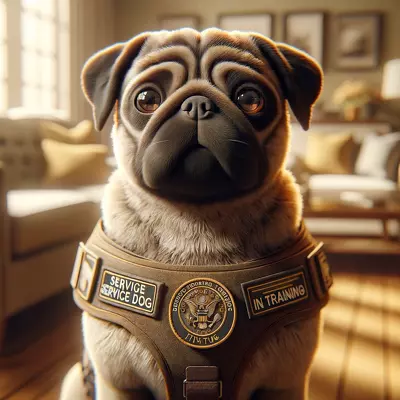Paws for Support: How Pugs are Redefining the Role of Service Dogs in Our Lives

Service dogs play a vital role in assisting individuals with various disabilities, offering both physical support and companionship. While certain breeds are commonly associated with these tasks, the potential for less traditional breeds to fulfill such roles raises intriguing considerations. Specifically, the adaptability and temperament of pugs make them candidates for service dog work despite not fitting the conventional image. This exploration focuses on their capabilities and the unique benefits they may offer as service companions.
I. Introduction
Service dogs play an indispensable role in enhancing the quality of life for individuals with disabilities, providing assistance that ranges from physical support to therapeutic companionship. The evolution of service dogs has seen a wide variety of breeds stepping into roles once thought to be exclusive to specific types, challenging preconceived notions about what a service dog looks like.
II. Understanding Service Dogs
A. Definition and Roles
Service dogs are trained to perform tasks for individuals with disabilities, including guiding blind people, alerting people who are deaf or hard of hearing, pulling wheelchairs, alerting them to seizures, and providing emotional support. The key distinction of a service dog lies in its training to offer specific assistance that mitigates its handler’s disability.
B. Common Breeds and Characteristics
Traditionally, breeds such as Labrador Retrievers, Golden Retrievers, and German Shepherds are chosen for service work due to their size, intelligence, and temperament. These breeds are known for their ability to learn complex tasks, their desire to please, and their stable demeanor.
C. Legal Protections and Rights
Service dogs are protected under laws such as the Americans with Disabilities Act (ADA) in the United States, which mandates that service dogs are allowed in public spaces where their handlers go. This legal framework ensures that individuals with service dogs can fully participate in society.
III. Pugs as Service Dogs
A. Temperament and Suitability
Pugs are known for their friendly, pleasant, and loyal nature, traits that are beneficial for certain types of service dog work. Their small size and affectionate demeanor make them particularly suited for roles in emotional support and therapy.
B. Training Requirements
Like all service dogs, pugs must undergo rigorous training to fulfill their roles effectively. This includes basic obedience training, specialized task training, and socialization to work in various environments. The adaptability of pugs can make them receptive to training, although their stubborn streak may require patience and consistency.
C. Advantages and Challenges
The compact size of pugs offers advantages in terms of ease of transport and accommodation, especially in urban settings. However, their brachycephalic (flat-faced) nature can pose health challenges, including respiratory issues, which may limit their ability to perform physically demanding tasks.
IV. Real-Life Examples
A. Success Stories
There are numerous accounts of pugs excelling in service roles, providing emotional support, and assisting with medical conditions. These success stories highlight the potential of pugs to serve as dedicated companions who improve the lives of their handlers.
B. Comparative Analysis with Traditional Service Dogs
Comparing pugs to traditional service dog breeds reveals differences in physical capabilities and training approaches. Yet, it also underscores the importance of matching the right dog to the specific needs and lifestyle of the handler rather than adhering strictly to breed stereotypes.
C. Case Studies
Case studies of pugs serving as service dogs illustrate the diverse ways in which these dogs support their handlers, from alerting to medical episodes to offering comfort in times of stress. These examples provide valuable insights into the practicalities and benefits of pugs in service roles.
V. Considerations for Potential Owners
A. Assessing a Pug’s Suitability
Prospective owners must consider their specific needs and whether a pug’s characteristics align with those requirements. Factors such as the dog’s health, temperament, and the nature of the assistance needed play crucial roles in this assessment.
B. Finding a Training Program
Identifying a training program that has experience with pugs and understands their unique needs is essential. Specialized training that accounts for the breed’s physical and behavioral traits can optimize their success as service dogs.
C. Preparing for a Service Dog Lifestyle
Adopting a service dog, including a pug, requires preparation and adjustment. Owners must be ready to commit to the training process, accommodate their dog’s needs, and navigate public access rights.
VI. FAQs
Q: Can pugs perform physical tasks as service dogs?
A: While pugs may face limitations in performing physically demanding tasks due to their size and health concerns, they can be trained for specific tasks that do not require heavy physical exertion.
Q: Are pugs recognized as service dogs under the ADA?
A: Yes, pugs can be recognized as service dogs under the ADA as long as they are individually trained to do work or perform tasks for a person with a disability.
Q: How long does it take to train a pug as a service dog?
A: The training duration can vary widely depending on the specific tasks and the individual dog’s learning pace. Typically, it can range from several months to over a year.
Q: Can a pug be trained for emotional support roles?
A: Pugs are absolutely well-suited for emotional support roles due to their affectionate and comforting nature.
Q: What are the main challenges in training a pug as a service dog?
A: The main challenges include their stubbornness during training, potential health issues related to their brachycephalic condition, and ensuring they can perform tasks reliably in diverse environments.
Q: How do I find a trainer experienced with pugs as service dogs?
A: Researching and connecting with organizations that specialize in service dog training, particularly those with experience in training a variety of breeds, is a good starting point.
Q: What is the difference between a service dog and a therapy dog?
A: A service dog is trained to perform specific tasks to assist an individual with a disability, while a therapy dog provides comfort and support in therapeutic settings and does not have the same public access rights as a service dog.
VII. Conclusion
A. The Potential of Pugs as Service Dogs
Pugs possess qualities that, with the right training, can make them excellent service dogs for individuals with certain needs, particularly in emotional support and therapy roles. Their success in these areas highlights the broader potential of diverse breeds in service work.
B. Making an Informed Decision
Choosing a pug as a service dog requires careful consideration of the individual’s needs, the dog’s health and capabilities, and the commitment to training and lifestyle adjustments. It’s a decision that can lead to a rewarding partnership, enhancing the well-being of both the handler and the dog.
C. Future Prospects in Service Dog Training
The inclusion of breeds like pugs in service roles challenges traditional perceptions and opens new avenues for exploring how different dogs can contribute to the field. As training methods evolve and awareness grows, the future of service dogs looks inclusive, promising diverse solutions for those in need.
VIII. Suggested Readings
Before exploring the role of pugs or any breed as a service dog, it’s beneficial to arm oneself with knowledge. The following books provide valuable insights into service dog training, the unique needs of individuals with disabilities, and the profound bond between humans and their canine companions.
- “The Power of Positive Dog Training” by Pat Miller – A guide to using positive reinforcement techniques in dog training, applicable to preparing a dog for service roles.
- “Service Dog: Training Your Own Service Dog” by Max Matthews – This book offers a step-by-step approach to training a service dog, including understanding legal rights and choosing the right dog for specific needs.
- “Canine Body Language: A Photographic Guide” by Brenda Aloff – Understanding canine body language is essential for effective training and bonding, making this book a valuable resource for prospective service dog trainers and owners.
- “Through a Dog’s Eyes” by Jennifer Arnold – Arnold provides insights into the world of service dogs and the incredible abilities they possess to change lives, offering inspiration and guidance for those considering a service dog.
After delving into these resources, readers will gain a broader perspective on the capabilities of dogs as service animals, the dedication required to train them, and the profound impact they can have on their handlers’ lives. Whether considering a pug or another breed, these books lay the groundwork for a successful partnership and a deeper appreciation for the service dog community.






